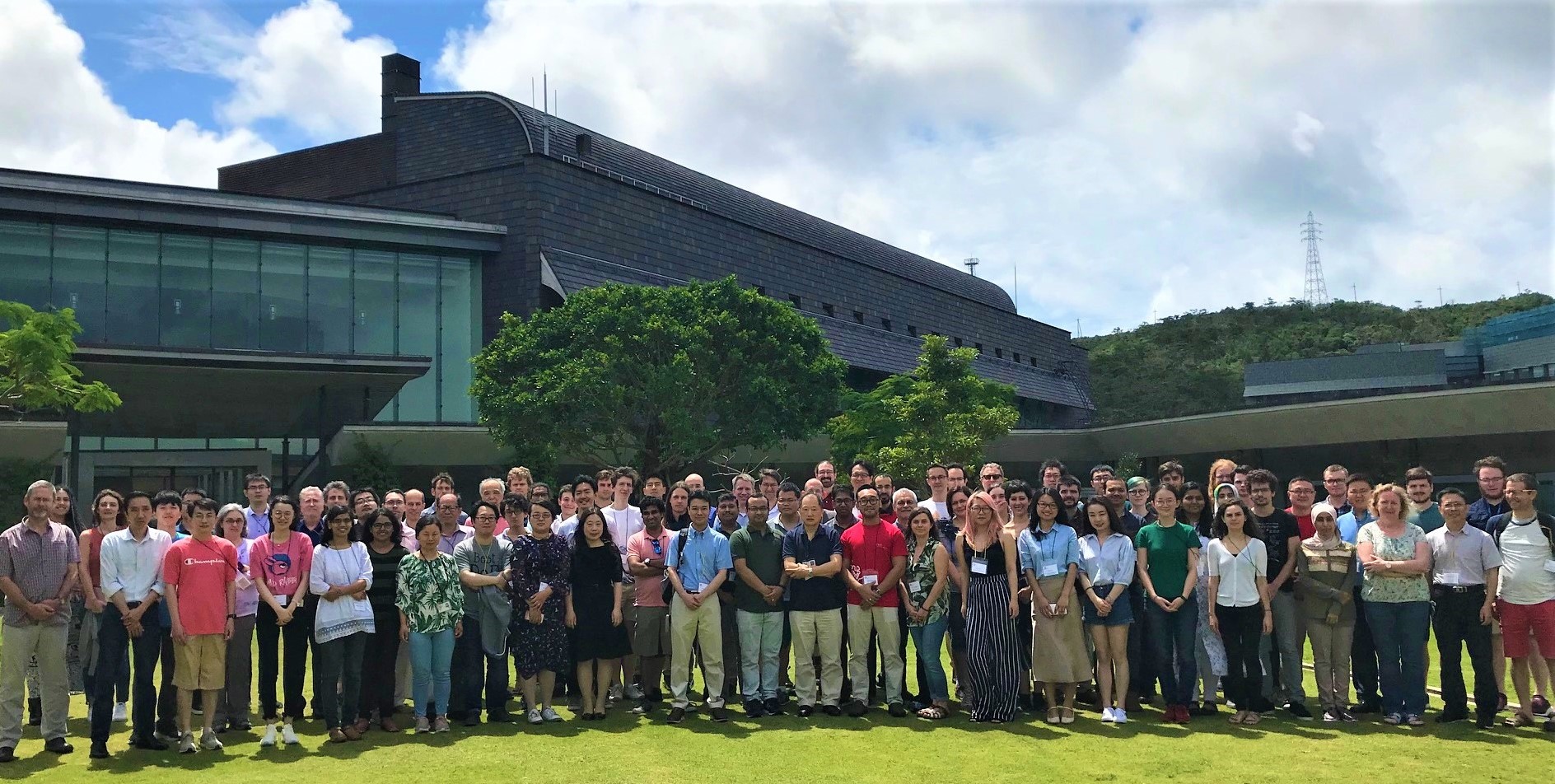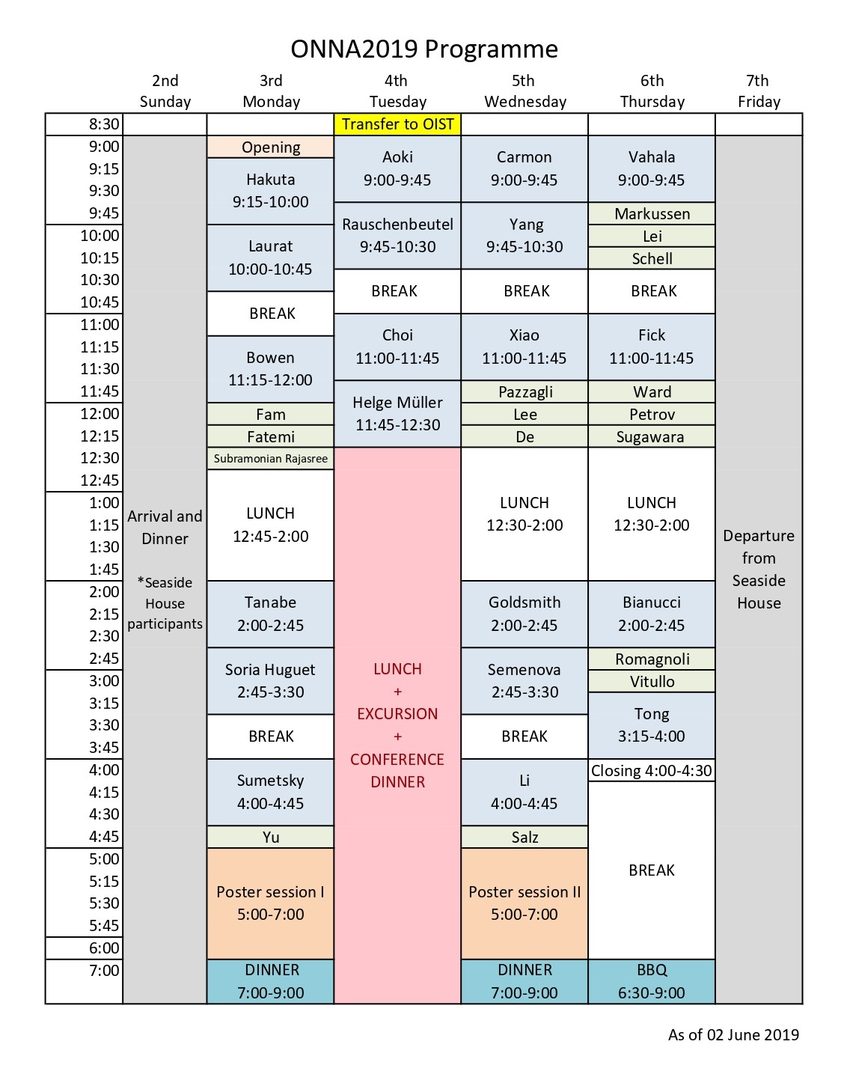Lan Yang (Washington University in St. Louis, USA)
Whispering-gallery-mode resonators: a versatile platform for light-matter interactions
ONNA2019

Optical Nanofibre Applications: From Quantum to Bio Technologies
ナノ光ファイバ―の諸応用:量子技術からバイオ技術へ
ONNA2019 3 - 6 June 2019 Okinawa, Japan
Following from the success of ONNA2013, 2015 & 2017, the ONNA2019 workshop will be held at OIST Graduate University (http://www.oist.jp) from 3-6 June 2019. The aim of the workshop is to bring together experts and early stage researchers from diverse communities who use optical micro and nanofibres for their research needs, whether it be for quantum, sensing, or other applications.
Important Dates:
- Begin Accepting Applications: 10 October 2018
- Early Application Selection: 31 January 2019 We encourage applying before this date as priority will be given to these applicants.
- Late Application Deadline: 28 February 2019 or until all places filled if earlier. We will only accept applications after 31 January if we still have capacity and have not finalised our list of selected participants. (Closed)
- Notification of Application Results: From mid-February 2019
- Participants arrive in Okinawa: 2 June 2019
- Participants depart Okinawa: 7 June 2019
Location: OIST Seaside House, Onna, Okinawa, Japan
Organisers: Síle Nic Chormaic CHAIR (OIST Graduate University, Japan), Lan Yang (Washington University in St. Louis, USA), Michael (Misha) Sumetsky (Aston University, UK), and Takao Aoki (Waseda University, Japan). Workshop hosted by the Light-Matter Interactions Unit.
Speakers
Takao Aoki (Waseda University, Japan)
Coupled-cavities quantum electrodynamics with optical nanofibers and trapped atoms
Pablo Bianucci (Concordia University, Canada)
Microfibers to create light confinement and to measure it
Warwick Bowen (University of Queensland, Australia)
Quantum-limited evanescent single-molecule biosensing
Tal Carmon (Technion-Israel Institute of Technology, Israel)
Coupling nano-tapers to liquids-, moving-, and tweezed-resonators for levitating optical-circuit and pico-mechanical systems
Kyung Soo Choi (University of Waterloo, Canada)
Many-body QED with atoms and photons: A new platform for quantum many-body optical physics
Jochen Fick (Institut NEEL, France)
Optical fiber nano-tweezers for micro- and nanoparticle trapping
Randall H Goldsmith (University of Wisconsin, USA)
Photonic-plasmonic hybridization explored via single-particle microresonator spectroscopy
Kohzo Hakuta (The University of Electro-Communications, Japan)
Nanofiber cavity QED
Julien Laurat (Laboratoire Kastler Brossel, France)
Waveguide-coupled single collective excitation of trapped atomic arrays
Ying Lia Li (University College London, England)
Commercialising whispering gallery mode accelerometers: from field-testing to chip-scale fabrication
Jörg Helge Müller (Niels Bohr Institute, Denmark)
Dipole force management and laser cooling of nanofiber trapped atoms
Arno Rauschenbeutel (Humboldt-Universität zu Berlin, Germany)
Observation of ultra-strong spin-motion coupling for nanofiber-trapped atoms
Yuliya Semenova (Technological University Dublin, Ireland)
Ultra-sensitive gas detection with microfibers and fiber microresonators
Silvia Soria Huguet (CNR-IFAC Institute of Applied Physics, Italy)
Microbubble resonators: PhoXonic devices and their applications
Michael (Misha) Sumetsky (Aston University, England)
Mahaux-Weidenmüller approach to cavity quantum electrodynamics
Takasumi Tanabe (Keio University, Japan)
Efficient coupling of whispering-gallery-mode silica toroid microcavity to planer silicon platform
Limin Tong (Zhejiang University, China)
Optical microfibers and nanofibers for ultrafast photonics
Kerry Vahala (Caltech, USA)
Earth rotation measurement and exceptional-point Sagnac enhancement in a silicon-chip-based Brillouin laser gyroscope
Yun-Feng Xiao (Peking University, China)
Chaos-assisted nanofiber-microcavity coupling and its applications
Rui Asaoka, Meiji University, Japan
Parameter optimization in photonic quantum gate assisted by cavity-QED system (P-1)
Jérémy Berroir, Laboratoire Kastler-Brossel - Sorbonne Université, France
Quantum optics with nanofibered-trapped atomic arrays in the evanescent field (P-1)
Jean-Baptiste Ceppe, OIST Graduate University, Japan
Experimental studies on modal coupling in rare-earth whispering gallery mode micro-lasers (P-1)
Sankar De, Saha Institute of Nuclear Physics, India
Controlling the coherent phenomena in an N-type atomic system (C7)
Royce Dong, Washington University in St. Louis, USA
The angle-polished fiber coupler for optical resonators (P-1)
Cindy Liza Esporlas, OIST Graduate University, Japan
Light-matter interaction of Janus particles near ultrathin optical fibers (P-1)
Jesse Everett, OIST Graduate University, Japan
Quantum information processing with nanofiber-coupled atoms (P-1)
Fredrik Fatemi, Army Research Laboratory, USA
Progress toward observing non-Markovian effects in optical nanofibers (C2)
Gabriella Gardosi, Aston University, England
Slow-cooked SNAP resonators (P-1)
Vandna Gokhroo, OIST Graduate University, Japan
Electric quadrupole excitation in 87Rb using an ONF (P-1)
Ratnesh Kumar Gupta, OIST Graduate University, Japan
Orbital angular momentum distribution in degenerate four-wave mixing in rubidium vapor (P-1)
Yanik Herrmann, Johannes Gutenberg-Universität Mainz, Germany
Fiber cavity coupled silicon-vacancy center for a quantum repeater Node (P-2)
Xinxin Hu, University of Science and Technology of China, China
Doubly-resonant-cavity electromagnetically induced transparency (P-1)
Di Hu, Johannes Gutenberg-University/ Institute of Physics, Germany
Exploring long-distance atom transportation in hollow-core fibers (P-1)
Foroogh Jafari, Shahid Beheshti University, Iran
Diameter measurement of optical microfiber using modal evolution (P-1)
Muhammed Shafi K, University of Electro-Communications, Japan
Hybrid system of an optical nanofiber and a single quantum dot operated at cryogenic temperatures (P-1)
Kristoffer Karlsson, OIST Graduate University, Japan
Formation of Rydberg atoms near an optical nanofibre (P-1)
Shinya Kato, PRESTO, JST, Japan
Observation of dressed states in coupled-cavities quantum electrodynamics (P-1)
Fam Le Kien, OIST Graduate University, Japan
Torque of guided light on an atom near an optical nanofiber (C1)
Danil Kornovan, ITMO University, Russia
Optical properties of quantum emitters interacting with the modes of an optical nanofiber: a theoretical study (P-1)
Aashutosh Kumar, Universite Grenoble Alpes/ Institute Neel, CNRS, France
Optical manipulation of microparticles in air (P-1)
Charlotte E Law, ORC, University of Southampton, England
Towards single-nanofibre coupling of excitation and emission for large fluorescent molecules and nanocrystals (P-1)
Hyoung In Lee, Seoul National University, Research Institute of Mathematics, South Korea
How backward Poynting flows arise for surface plasmon waves with lossy metals (C6)
Fuchuan Lei, OIST Graduate University, Japan
Polarization control for optical nanofibers (C10)
Angzhen Li, Key Lab of In-fiber Integrated Optics, Harbin Engineering University, China
A Tm3+-doped ZBYA glass microsphere laser in the 2.0 μm wavelength region (P-1)
Danran Li, Nanjing University, China
Hybrid PMMA–silica microfiber coupler gas sensor (P-1)
Xiao-Fei Liu, Beijing University of Posts and Telecommunications, China
Chiral microresonator assisted by Rydberg-atom ensembles (P-1)
Maki Maeda, OIST Graduate University, Japan
Towards investigation of light-matter interactions of single quantum emitters using multimode ultrathin fibre cavity (P-1)
Aseel Mahmood, Ministry of Science and Technology/ Materials Research Directorate, Iraq
A multifunctional photonic crystal fiber optical sensor for air pollution and radiation dosimetry (P-1)
Signe Markussen, Niels Bohr Institute, University of Copenhagen, Denmark
Analysing the radial motion of nanofiber trapped atoms with Ramsey spectroscopy (C9)
Md Ashadi Md Johari, University of Malaya, Malaysia
Effect of size on single and double optical microbottle resonator humidity sensors (P-2)
Kali Prasanna Nayak, University of Electro-Communications, Japan
Trapping single atoms on a nanofiber cavity (P-2)
Jing Pan, Zhe Jiang University, China
Ultrasensitive hybrid optical skin (P-2)
Sofia Pazzagli, TU-Wien / Atominstitut, Austria
Coupling single molecules to high-Q nanofiber-based microresonator (C5)
Mihail Petrov, ITMO University, Russia
Transverse optical binding of nanoparticles near a nanofiber and related optomechanical effects (C13)
Omid Reza Ranjbar Naeini, Laser and Plasma Research Institute, Iran
The effect of acetone gas concentration on polymeric tapered optical fiber sensor (P-2)
Kristine Faith Roque, OIST Graduate University, Japan
Single protein trapping with plasmonic optical tweezers (P-2)
Priscila Romagnoli, OIST Graduate University, Japan
Structured nanofibre-based cavities by focussed ion beam milling (C15)
Marcel Salz, Johannes Gutenberg-Universität Mainz, Germany
Fiber cavity coupled silicon-vacancy center for a quantum repeater node (C8)
Andreas Schell, CEITEC / Brno University of Technology, Czech Republic
Single photon extraction from defects in hBN using a tapered fiber (C11)
Erwan Stourm, Universite Paris-Sud, France
Rydberg atom close to an optical nanofibre (P-2)
Krishnapriya Subramonian Rajasree, OIST Graduate University, Japan
Formation of Rydberg atoms near an optical nanofibre (C3)
Masakazu Sugawara, Tohoku University, Japan
Optical measurement for realizing a polarized single photon source by a gold nanorod-quantum dot coupled system (C14)
Ivan Toftul, ITMO University, Russia
Self-induced anisotropy of spherical nanoparticle near a nanofiber and related optomechanical effects (P-2)
Viet Giang Truong, OIST Graduate University, Japan
Optical forces induced on a particle in the evanescent fields of guided higher order ultrathin fibre modes (P-2)
Takeru Utsugi, Waseda University, Japan
Temporal shape and efficiency of single-photon generation based on cavity quantum electrodynamics (P-2)
Dashiell Vitullo, U. S. Army Research Laboratory, USA
Fine tuning of SNAP microresonators (C16)
Min Wang, Tsinghua University, China
Characterization of microresonator-geometry-deformation for cavity optomechanics (P-2)
Jonathan Ward, OIST Graduate University, Japan
"Point-and-play", fiber-based, optical nano-antenna for excitation of whispering gallery modes (C12)
Donald White, Waseda University, Japan
Cavity dark mode of distant coupled atom-cavity systems (P-2)
Yu Yin, Harbin Engineering University, China
Au nanoclusters functionlized microfibre coil resonator for temperature measurement (P-2)
Takaaki Yoshino, Tohoku University, Japan
Transportation of Liposomes in the evanescent field of an optical nanofiber (P-2)
Jibo Yu, Harbin Engineering University, China
I. Compound glass materials based microsphere lasers (C4)
Jibo Yu, Harbin Engineering University, China
II. Brillouin scattering optomechanical excitation of surface acoustic waves in high-Q chalcogenide microsphere (P-2)
Sajid Zaki, Aston University, England
Fabrication of SNAP resonators using beam shaping techniques (P-2)
Pengfei Zhang, Shanxi University, China
Nondestructive measurement of nanofiber diameters using a microfiber tip (P-2)
Programme

ONNA2019 poster sessions are sponsored by



